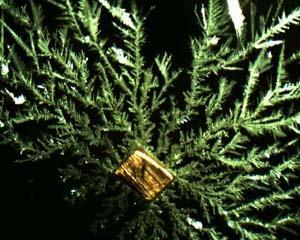Watch silver crystals grow in this captivating experiment
For me, this is one of the most beautiful demonstrations. Watching fractal-like silver crystals grow is captivating, whatever your age.
Forming silver crystals
This demonstration can be used as a simple introduction to reactivity or to provide an in-depth discussion of electrochemistry.

Kit
- 0.1 mol dm-3 silver nitrate solution (irritant: skin and eyes);
- Pipette dropper;
- Petri dish;
- Microscope with 40× zoom;
- Copper foil (0.3 mm thickness);
- Scissors;
- tweezers;
- View camera attached to microscope;
- or microscope with integrated digital camera;
- Laptop computer and a projector (all optional).
Safety
Silver nitrate solution is an irritant, wear eye protection and avoid skin contact.
Procedure
Using scissors, cut a very thin slice from the copper sheet. From this slice, cut off the smallest speck that you can see and handle, thus ensuring you have freshly cut edges which are not corroded. Using tweezers, put the speck on a petri dish and place the dish under a microscope. (Note: for smaller microscopes a glass slide can be used instead of a petri dish.)
Focus the microscope on the copper using ca 40× magnification (I use a 10× eye piece and 4× object lens). Carefully add one drop of silver nitrate solution to the copper and refocus the microscope. Crystals of silver will start to grow from the edges of the copper. Enough silver is produced at this magnification to fill the view within minutes.
To show the demonstration to a class of students link a microscope to a view camera, or as I do, use a microscope with an integrated digital camera set at 40× magnification, linked to a laptop computer which is linked to a projector. By using a microscope with an integrated digital camera still images can be recorded, printed and included in the students' notes.
An alternative way to demonstrate this displacement reaction is to drop a 5 cm piece of 0.5 mm copper wire into a 8 cm depth of silver nitrate solution in a boiling tube. The displacement reaction can be seen with the naked eye, but the crystalline structure of the silver is hard to make out.
Special tips
Most microscopes have the light source positioned below the sample platform, which produces a dark outline of the crystals formed. I switch off the light source and, on dark days, shine an LED, clamped in position using a retort stand and clamp, onto the sample from above to see the silver crystals in their true glory. If it is a sunny day, natural light can be used by positioning the microscope near a window.
Take care not to reflect direct sunlight. If this is focused by a lens it can cause blindness.
When you add the silver nitrate to the copper, the speck of copper can become suspended on the surface tension of the drop. You will need to sink the copper before the reaction will work effectively. The three dimensional crystal structures will not stay in focus because their thickness varies and so constant focal adjustments are required.
Teaching goals
By investigating a series of displacement reactions leaners aged 11–14 can learn about the reactivity series of metals. Set up a series of test-tube reactions to investigate the displacement reactions between metals such as silver, lead, zinc, copper and magnesium and the salts (eg sulfate, nitrate, chloride) of each of the other metals. (Note: 0.1 M lead nitrate is toxic.) Alternatively, you can do this in microscale using spotting tiles, which can be laid out in the same format as the table students use to record their results.
Find more
- See How to teach displacement reactions at 11–14 for more ideas and tips.
- Watch our reactivity series of metals practical video to see metal displacement reactions set up in microscale (at 10:35) and find additional resources.
When teaching age 14-16 students about metallic bonding in the structure and bonding topic this demonstration can be used to illustrate the crystalline structure of metals.
Post-16, students 'enjoy' this simple experiment as an introduction to electrochemistry. The experiment is by no means an electrochemical cell under standard conditions employing a salt bridge, 1 mol dm-3 solutions, and using a high resistance voltmeter to reduce current flow, but it is worth showing to post-16 students.
By seeing the crystals grow, students can imagine the Ag+ ions pulling electrons off the silver crystals, which in turn remove electrons from the lump of copper and produce copper ions, thus setting up a simple electrochemical circuit. For each copper ion that forms in solution, two silver ions will add to the silver crystal structure.
This is important to demonstrate because students might hold the misconception that the reaction takes place by silver ions colliding with the copper, which is not the case.







No comments yet